2001 FORD F250 height
[x] Cancel search: heightPage 99 of 288
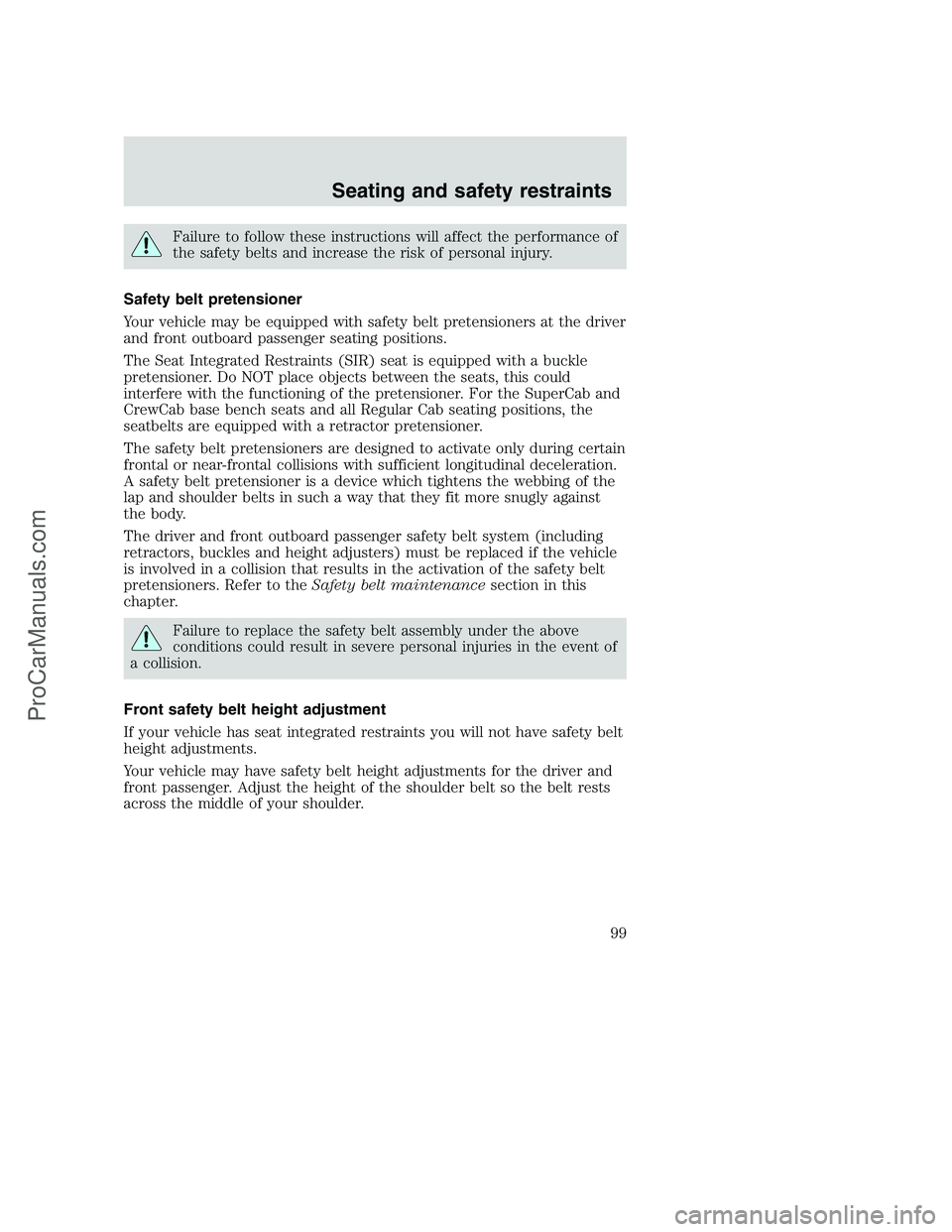
Failure to follow these instructions will affect the performance of
the safety belts and increase the risk of personal injury.
Safety belt pretensioner
Your vehicle may be equipped with safety belt pretensioners at the driver
and front outboard passenger seating positions.
The Seat Integrated Restraints (SIR) seat is equipped with a buckle
pretensioner. Do NOT place objects between the seats, this could
interfere with the functioning of the pretensioner. For the SuperCab and
CrewCab base bench seats and all Regular Cab seating positions, the
seatbelts are equipped with a retractor pretensioner.
The safety belt pretensioners are designed to activate only during certain
frontal or near-frontal collisions with sufficient longitudinal deceleration.
A safety belt pretensioner is a device which tightens the webbing of the
lap and shoulder belts in such a way that they fit more snugly against
the body.
The driver and front outboard passenger safety belt system (including
retractors, buckles and height adjusters) must be replaced if the vehicle
is involved in a collision that results in the activation of the safety belt
pretensioners. Refer to theSafety belt maintenancesection in this
chapter.
Failure to replace the safety belt assembly under the above
conditions could result in severe personal injuries in the event of
a collision.
Front safety belt height adjustment
If your vehicle has seat integrated restraints you will not have safety belt
height adjustments.
Your vehicle may have safety belt height adjustments for the driver and
front passenger. Adjust the height of the shoulder belt so the belt rests
across the middle of your shoulder.
Seating and safety restraints
99
ProCarManuals.com
Page 101 of 288
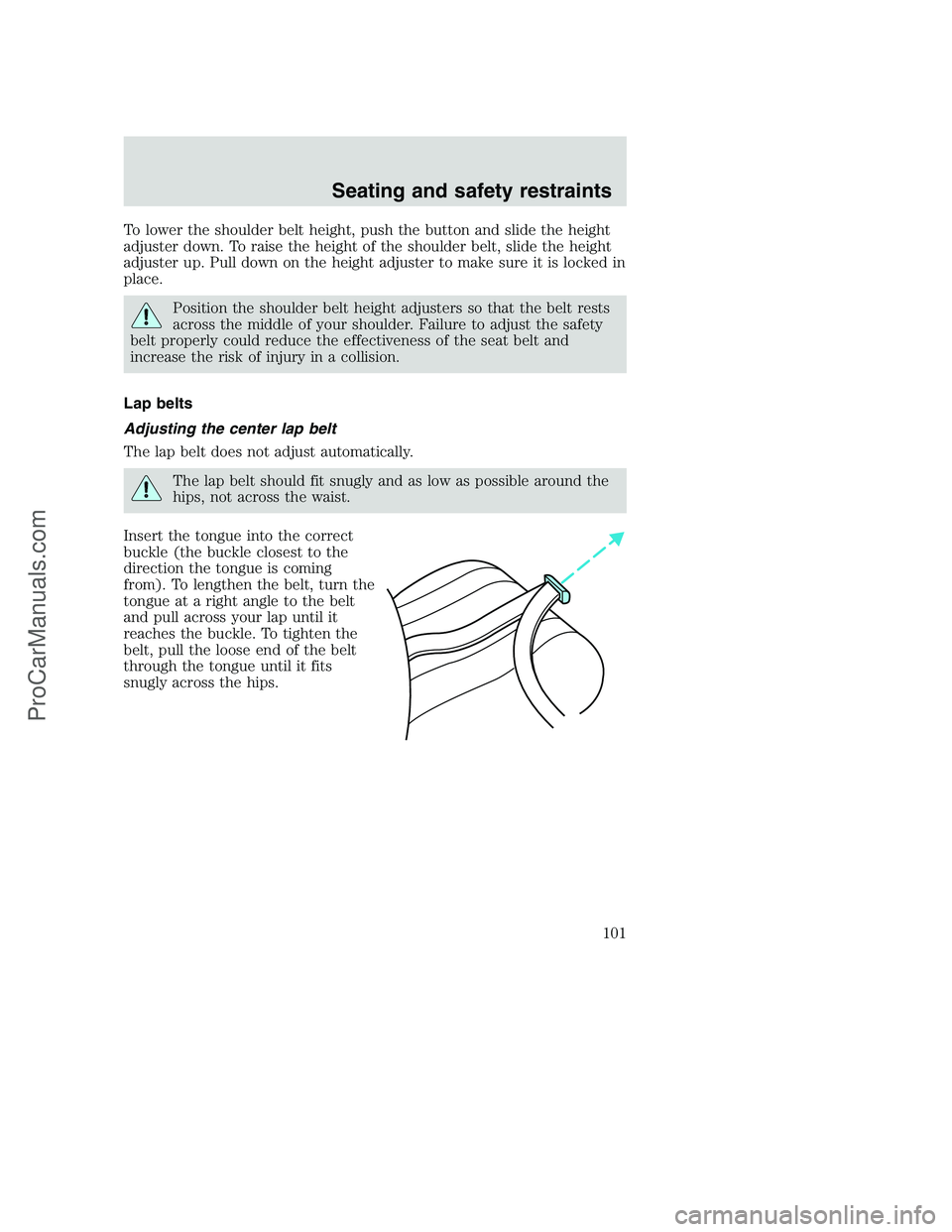
To lower the shoulder belt height, push the button and slide the height
adjuster down. To raise the height of the shoulder belt, slide the height
adjuster up. Pull down on the height adjuster to make sure it is locked in
place.
Position the shoulder belt height adjusters so that the belt rests
across the middle of your shoulder. Failure to adjust the safety
belt properly could reduce the effectiveness of the seat belt and
increase the risk of injury in a collision.
Lap belts
Adjusting the center lap belt
The lap belt does not adjust automatically.
The lap belt should fit snugly and as low as possible around the
hips, not across the waist.
Insert the tongue into the correct
buckle (the buckle closest to the
direction the tongue is coming
from). To lengthen the belt, turn the
tongue at a right angle to the belt
and pull across your lap until it
reaches the buckle. To tighten the
belt, pull the loose end of the belt
through the tongue until it fits
snugly across the hips.
Seating and safety restraints
101
ProCarManuals.com
Page 106 of 288
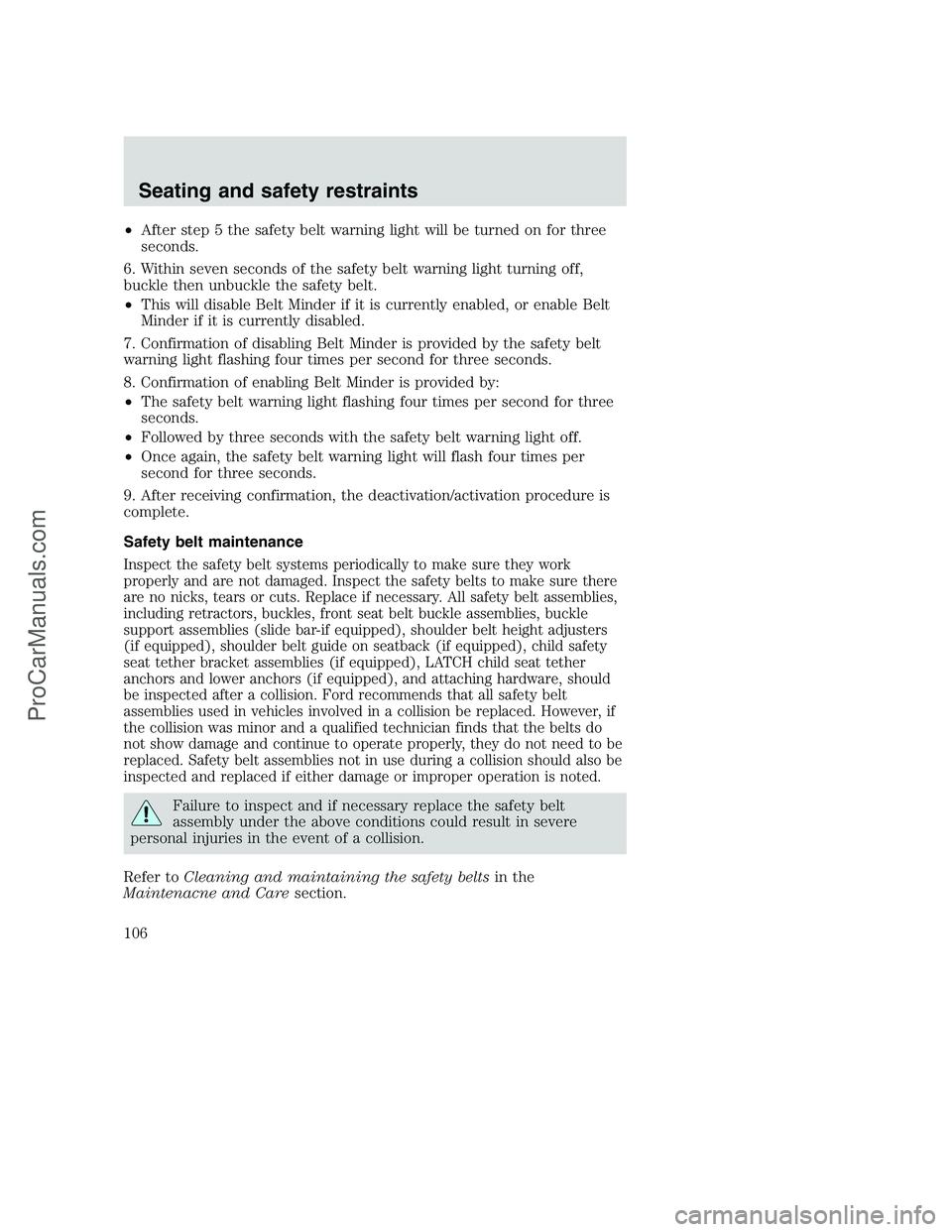
•After step 5 the safety belt warning light will be turned on for three
seconds.
6. Within seven seconds of the safety belt warning light turning off,
buckle then unbuckle the safety belt.
•This will disable Belt Minder if it is currently enabled, or enable Belt
Minder if it is currently disabled.
7. Confirmation of disabling Belt Minder is provided by the safety belt
warning light flashing four times per second for three seconds.
8. Confirmation of enabling Belt Minder is provided by:
•The safety belt warning light flashing four times per second for three
seconds.
•Followed by three seconds with the safety belt warning light off.
•Once again, the safety belt warning light will flash four times per
second for three seconds.
9. After receiving confirmation, the deactivation/activation procedure is
complete.
Safety belt maintenance
Inspect the safety belt systems periodically to make sure they work
properly and are not damaged. Inspect the safety belts to make sure there
are no nicks, tears or cuts. Replace if necessary. All safety belt assemblies,
including retractors, buckles, front seat belt buckle assemblies, buckle
support assemblies (slide bar-if equipped), shoulder belt height adjusters
(if equipped), shoulder belt guide on seatback (if equipped), child safety
seat tether bracket assemblies (if equipped), LATCH child seat tether
anchors and lower anchors (if equipped), and attaching hardware, should
be inspected after a collision. Ford recommends that all safety belt
assemblies used in vehicles involved in a collision be replaced. However, if
the collision was minor and a qualified technician finds that the belts do
not show damage and continue to operate properly, they do not need to be
replaced. Safety belt assemblies not in use during a collision should also be
inspected and replaced if either damage or improper operation is noted.
Failure to inspect and if necessary replace the safety belt
assembly under the above conditions could result in severe
personal injuries in the event of a collision.
Refer toCleaning and maintaining the safety beltsin the
Maintenacne and Caresection.
Seating and safety restraints
106
ProCarManuals.com
Page 160 of 288
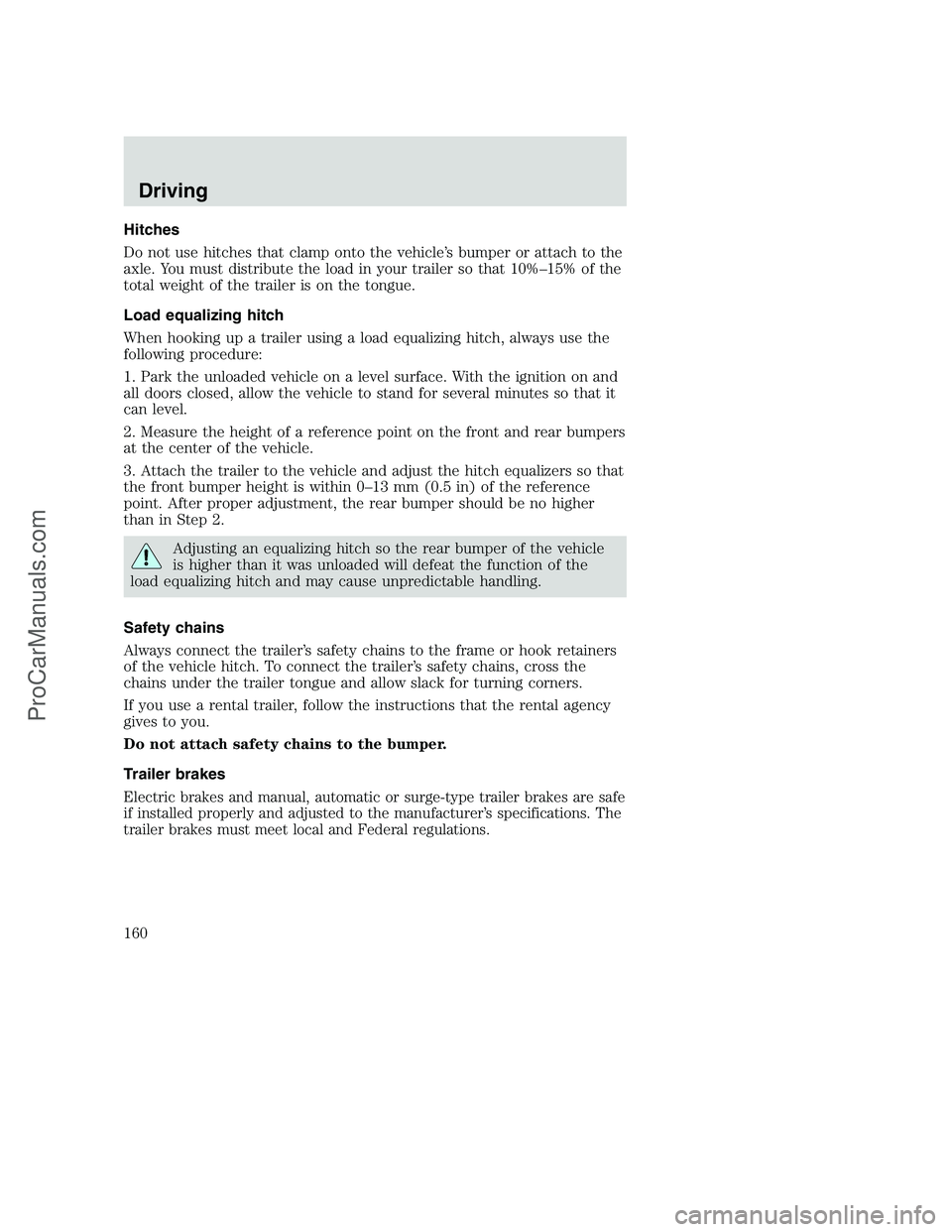
Hitches
Do not use hitches that clamp onto the vehicle’s bumper or attach to the
axle. You must distribute the load in your trailer so that 10%–15% of the
total weight of the trailer is on the tongue.
Load equalizing hitch
When hooking up a trailer using a load equalizing hitch, always use the
following procedure:
1. Park the unloaded vehicle on a level surface. With the ignition on and
all doors closed, allow the vehicle to stand for several minutes so that it
can level.
2. Measure the height of a reference point on the front and rear bumpers
at the center of the vehicle.
3. Attach the trailer to the vehicle and adjust the hitch equalizers so that
the front bumper height is within 0–13 mm (0.5 in) of the reference
point. After proper adjustment, the rear bumper should be no higher
than in Step 2.
Adjusting an equalizing hitch so the rear bumper of the vehicle
is higher than it was unloaded will defeat the function of the
load equalizing hitch and may cause unpredictable handling.
Safety chains
Always connect the trailer’s safety chains to the frame or hook retainers
of the vehicle hitch. To connect the trailer’s safety chains, cross the
chains under the trailer tongue and allow slack for turning corners.
If you use a rental trailer, follow the instructions that the rental agency
gives to you.
Do not attach safety chains to the bumper.
Trailer brakes
Electric brakes and manual, automatic or surge-type trailer brakes are safe
if installed properly and adjusted to the manufacturer’s specifications. The
trailer brakes must meet local and Federal regulations.
Driving
160
ProCarManuals.com
Page 164 of 288

•The Front Axle Accessory Reserve Capacity and the Total Accessory
Reserve Capacity listed on the bottom right of the Safety Compliance
Certification Label will determine whether or not the addition of a
snowplow will overload your vehicle.
•The weight of the snowplow and supporting components distributed to
the front axle must not exceed the front accessory reserve capacity.
•The total weight of the snowplow and aftermarket equipment must
not exceed the Total Accessory Reserve Capacity.
•The weight of the installed snowplow and aftermarket equipment must
not load the vehicle beyond the GAWR (front/rear) and GVWR listed
on the Safety Compliance Certification Label.
•The total weight of the snowplow and aftermarket equipment must be
considered part of the payload and must not exceed the Gross
Combined Weight Rating (GCWR) for towing.
•Federal and most local regulations require additional exterior lamps
for snowplow-equipped vehicles. Consult your dealer for additional
information.
•After installing a snowplow to the vehicle, ensure the vehicle’s front
toe alignment and front ride height are within specification (reset if
required). These specifications are located in the vehicle’s Workshop
Manual. Adherence to the toe, tire pressures and ride height
specification is important for proper tire wear, ride, handling and
headlight aim. Also, maintain the engine oil and transmission fluid
change intervals following the severe duty schedule.
Do not exceed the GVWR or the GAWR specified on the
certification label.
Removing snowplow
Read the following instructions before removing a snowplow:
•After removing a snowplow from the vehicle, ensure the vehicle’s front
toe alignment and front ride height are within specification (reset if
required). These specifications are located in the vehicle’s Workshop
Manual. Adherence to the toe and ride height specification is
important for proper tire wear, ride, handling and headlight aim.
Driving
164
ProCarManuals.com
Page 256 of 288
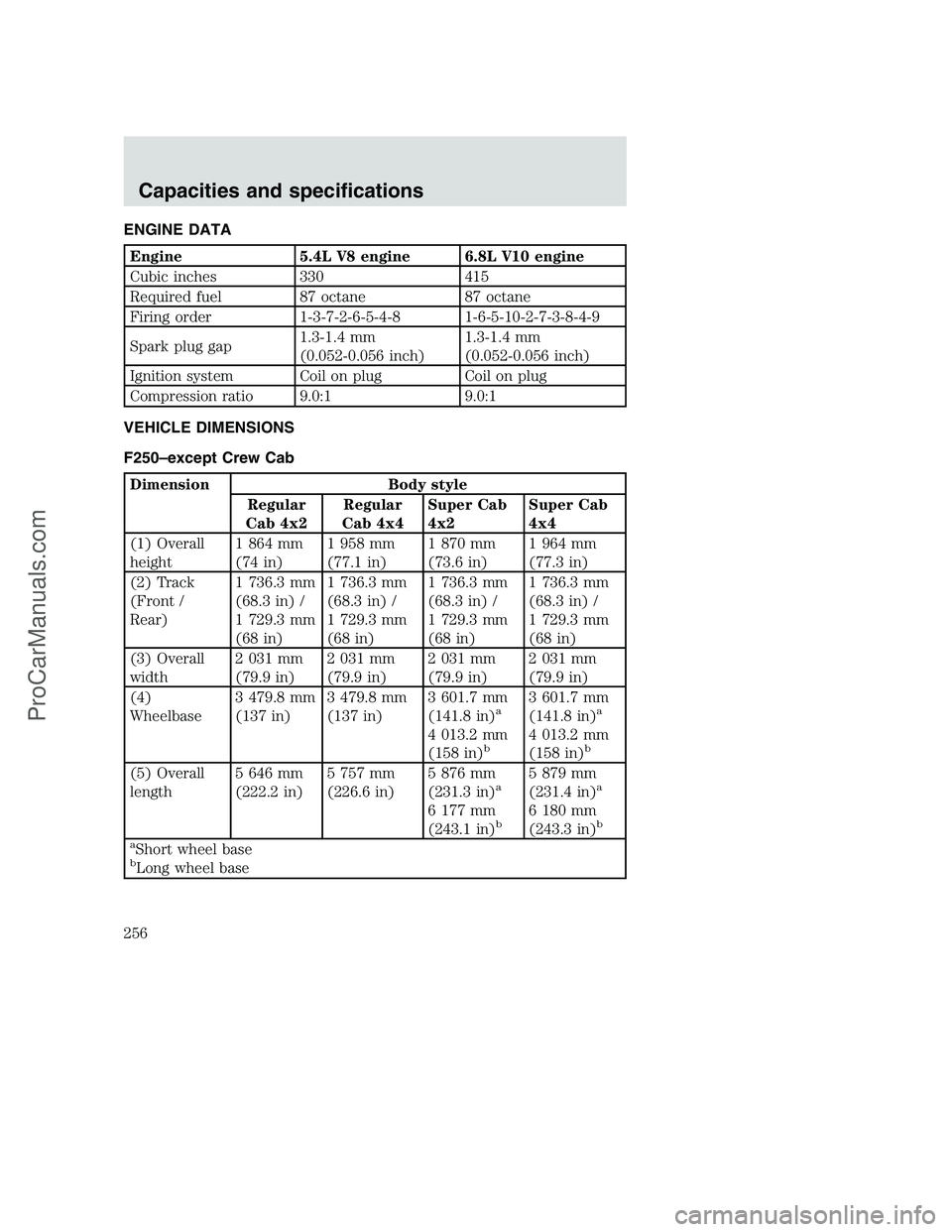
ENGINE DATA
Engine 5.4L V8 engine 6.8L V10 engine
Cubic inches 330 415
Required fuel 87 octane 87 octane
Firing order 1-3-7-2-6-5-4-8 1-6-5-10-2-7-3-8-4-9
Spark plug gap1.3-1.4 mm
(0.052-0.056 inch)1.3-1.4 mm
(0.052-0.056 inch)
Ignition system Coil on plug Coil on plug
Compression ratio 9.0:1 9.0:1
VEHICLE DIMENSIONS
F250–except Crew Cab
Dimension Body style
Regular
Cab 4x2Regular
Cab 4x4Super Cab
4x2Super Cab
4x4
(1) Overall
height1 864 mm
(74 in)1 958 mm
(77.1 in)1 870 mm
(73.6 in)1 964 mm
(77.3 in)
(2) Track
(Front /
Rear)1 736.3 mm
(68.3 in) /
1 729.3 mm
(68 in)1 736.3 mm
(68.3 in) /
1 729.3 mm
(68 in)1 736.3 mm
(68.3 in) /
1 729.3 mm
(68 in)1 736.3 mm
(68.3 in) /
1 729.3 mm
(68 in)
(3) Overall
width2 031 mm
(79.9 in)2 031 mm
(79.9 in)2 031 mm
(79.9 in)2 031 mm
(79.9 in)
(4)
Wheelbase3 479.8 mm
(137 in)3 479.8 mm
(137 in)3 601.7 mm
(141.8 in)
a
4 013.2 mm
(158 in)b
3 601.7 mm
(141.8 in)a
4 013.2 mm
(158 in)b
(5) Overall
length5 646 mm
(222.2 in)5 757 mm
(226.6 in)5 876 mm
(231.3 in)a
6 177 mm
(243.1 in)b
5 879 mm
(231.4 in)a
6 180 mm
(243.3 in)b
a
Short wheel basebLong wheel base
Capacities and specifications
256
ProCarManuals.com
Page 257 of 288

F250-Crew Cab
Dimension Body style
Crew Cab 4x2 Crew Cab 4x4
(1) Overall height 1 960 mm (77.2 in)
a/
1 883 mm (74.1 in)b2 053mm (80.8 in)a/
2 052 mm (80.8 in)b
(2) Track (Front /
Rear)1 745 mm (68.7 in)/
1 729 mm (68.1 in)a,b1 736 mm (68.4 in)/
1 729 mm (68.1 in)a,b
(3) Overall width 1 988 mm (78.3 in)a,b1 988 mm (78.3 in)a,b
(4) Wheelbase 3 967 mm (156.2 in )a/
4 379 mm (172.4 in)b3 967 mm (156.2 in )a/
4 379 mm (172.4 in)b
(5) Overall length 6 242 mm (245.8 in)a/
6 654 mm (262.0 in)b6 242 mm (245.8 in)a/
6 654 mm (262.0 in)b
a
Short wheel basebLong wheel base
F350–except Crew Cab
Dimension Body style
Chassis
CabRegular
CabSuper Cab
4x2Super Cab
4x4
(1) Overall
height1 972 mm
(77.6 in)1 860 mm
(73.2 in)
c,e1 865 mm
(73.4 in)a
1 861 mm
(73.6 in)b
1 960 mm
(77.2 in)
(2) Track
(Front /
Rear)1 736.3 mm
(68.3 in) /
1 879.6 mm
(74.0 in)1 736.3 mm
(68.3 in) /
1 729.3 mm
(68.0 in)1 736.3 mm
(68.3 in) /
1 729.3 mm
(68.0 in)
a,c
1 736.3 mm
(68.3 in) /
1879.6 mm
(74.0 in)
b,d
1 737.3 mm
(68.4 in) /
1 729.3 mm
(68.0 in)
(3) Overall
width2 025 mm
(79.7 in)2 031 mm
(79.9 in)2 031 mm
(79.9 in)2 031 mm
(79.9 in)
Capacities and specifications
257
ProCarManuals.com
Page 258 of 288
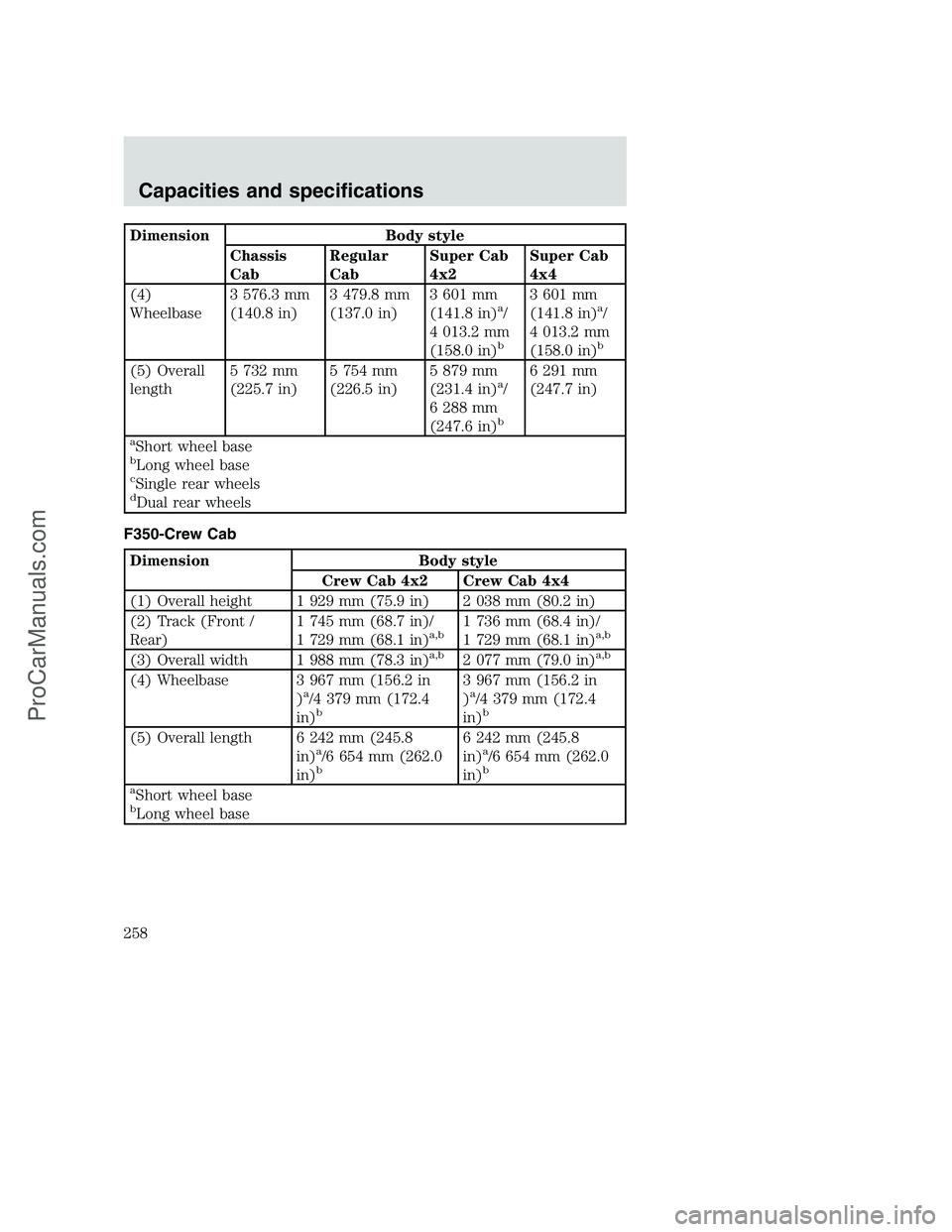
Dimension Body style
Chassis
CabRegular
CabSuper Cab
4x2Super Cab
4x4
(4)
Wheelbase3 576.3 mm
(140.8 in)3 479.8 mm
(137.0 in)3 601 mm
(141.8 in)
a/
4 013.2 mm
(158.0 in)
b
3 601 mm
(141.8 in)a/
4 013.2 mm
(158.0 in)
b
(5) Overall
length5 732 mm
(225.7 in)5 754 mm
(226.5 in)5 879 mm
(231.4 in)a/
6 288 mm
(247.6 in)
b
6 291 mm
(247.7 in)
aShort wheel basebLong wheel basecSingle rear wheelsdDual rear wheels
F350-Crew Cab
Dimension Body style
Crew Cab 4x2 Crew Cab 4x4
(1) Overall height 1 929 mm (75.9 in) 2 038 mm (80.2 in)
(2) Track (Front /
Rear)1 745 mm (68.7 in)/
1 729 mm (68.1 in)
a,b1 736 mm (68.4 in)/
1 729 mm (68.1 in)a,b
(3) Overall width 1 988 mm (78.3 in)a,b2 077 mm (79.0 in)a,b
(4) Wheelbase 3 967 mm (156.2 in
)a/4 379 mm (172.4
in)b
3 967 mm (156.2 in
)a/4 379 mm (172.4
in)b
(5) Overall length 6 242 mm (245.8
in)a/6 654 mm (262.0
in)b
6 242 mm (245.8
in)a/6 654 mm (262.0
in)b
a
Short wheel basebLong wheel base
Capacities and specifications
258
ProCarManuals.com